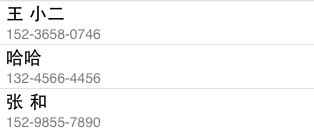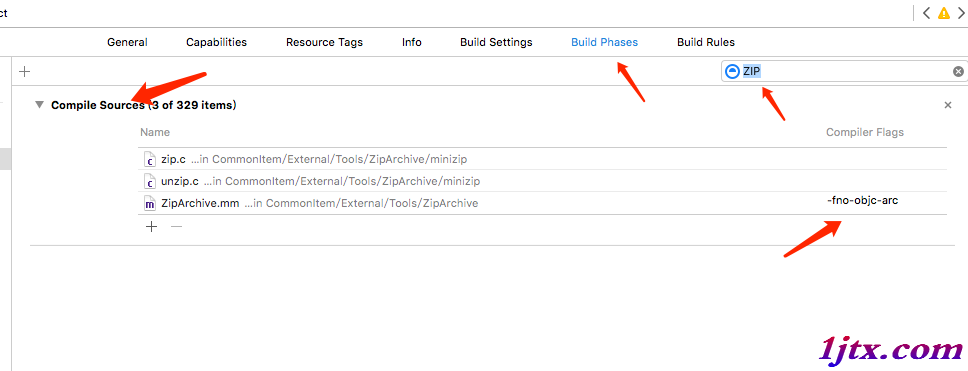IOS開發(25)之刪除UITableView的Cell
1 前言
今天我們來學習一下怎樣從UITableView中滑動刪除Cell數據。
2 代碼實例
ZYViewController.h
[plain]
#import <UIKit/UIKit.h>
@interface ZYViewController : UIViewController<UITableViewDelegate,UITableViewDataSource>//添加代理
@property(nonatomic,strong) UITableView *myTableView;
@property(nonatomic,strong) NSMutableArray *arryOfRows;
@end
#import <UIKit/UIKit.h>
@interface ZYViewController : UIViewController<UITableViewDelegate,UITableViewDataSource>//添加代理
@property(nonatomic,strong) UITableView *myTableView;
@property(nonatomic,strong) NSMutableArray *arryOfRows;
@end
ZYViewController.m
[plain]
@synthesize myTableView;
@synthesize arryOfRows;
- (void)viewDidLoad
{
[super viewDidLoad];
// Do any additional setup after loading the view, typically from a nib.
self.view.backgroundColor = [UIColor whiteColor];
myTableView = [[UITableView alloc] initWithFrame:self.view.bounds style:UITableViewStylePlain];//設置列表樣式為簡單的樣式 還有一個樣式為UITableViewStyleGrouped為分組模式 UITableViewStylePlain為普通的樣式
self.myTableView.delegate = self;//設置代理為自身
myTableView.dataSource = self;//設置數據源為自身
self.myTableView.autoresizingMask = UIViewAutoresizingFlexibleWidth|UIViewAutoresizingFlexibleHeight;//確保TablView能夠正確的調整大小
arryOfRows = [[NSMutableArray alloc] initWithObjects:@"a",@"b",@"c", nil];//初始化表格數據
[self.view addSubview:myTableView];
}
//設置每行的高度
-(CGFloat) tableView:(UITableView *)tableView heightForRowAtIndexPath:(NSIndexPath *)indexPath{
CGFloat result = 20.0f;
if ([tableView isEqual:self.myTableView]) {
// result = 40.0f;
result = 80.0f;
}
return result;
}
////允許數據源告知必須加載到Table View中的表的Section數。
//-(NSInteger)numberOfSectionsInTableView:(UITableView *)tableView{
// NSInteger result = 0;
// if([tableView isEqual:myTableView]){
// result = 3;//一共三個section
// }
// return result;
//}
//設置每個Section呈現多少行
-(NSInteger)tableView:(UITableView *)tableView numberOfRowsInSection:(NSInteger)section{
return [self.arryOfRows count];
}
//每行對應的數據
-(UITableViewCell *) tableView:(UITableView *)tableView cellForRowAtIndexPath:(NSIndexPath *)indexPath{
UITableViewCell *result = nil;
if ([tableView isEqual:myTableView]) {
static NSString *tableViewCellIdentifier = @"MyCells";//設置Cell標識
result = [tableView dequeueReusableCellWithIdentifier:tableViewCellIdentifier];//通過標示符返回一個可重用的表視圖單元格對象
if (result == nil) {
result = [[UITableViewCell alloc] initWithStyle:UITableViewCellStyleDefault reuseIdentifier:tableViewCellIdentifier];//初始化一個表格單元格樣式和重用的標識符,並將它返回給調用者。
}
//indexPath.section 表示section的索引 indexPath.row表示行數的索引
result.textLabel.text = [arryOfRows objectAtIndex:indexPath.row];
}
return result;
}
//點擊某一行時候觸發的事件
-(void)tableView:(UITableView *)tableView didSelectRowAtIndexPath:(NSIndexPath *)indexPath{
if ([tableView isEqual:myTableView]) {
NSLog(@"%@",[NSString stringWithFormat:@"Cell %ld in Section %ld is selected",(long)indexPath.row,(long)indexPath.section]);
}
}
//要求委托方的編輯風格在表視圖的一個特定的位置。
-(UITableViewCellEditingStyle)tableView:(UITableView *)tableView editingStyleForRowAtIndexPath:(NSIndexPath *)indexPath{
UITableViewCellEditingStyle result = UITableViewCellEditingStyleNone;//默認沒有編輯風格
if ([tableView isEqual:myTableView]) {
result = UITableViewCellEditingStyleDelete;//設置編輯風格為刪除風格
}
return result;
}
-(void)setEditing:(BOOL)editing animated:(BOOL)animated{//設置是否顯示一個可編輯視圖的視圖控制器。
[super setEditing:editing animated:animated];
[self.myTableView setEditing:editing animated:animated];//切換接收者的進入和退出編輯模式。
}
-(void)tableView:(UITableView *)tableView commitEditingStyle:(UITableViewCellEditingStyle)editingStyle forRowAtIndexPath:(NSIndexPath *)indexPath{//請求數據源提交的插入或刪除指定行接收者。
if (editingStyle ==UITableViewCellEditingStyleDelete) {//如果編輯樣式為刪除樣式
if (indexPath.row<[self.arryOfRows count]) {
[self.arryOfRows removeObjectAtIndex:indexPath.row];//移除數據源的數據
[tableView deleteRowsAtIndexPaths:[NSArray arrayWithObject:indexPath] withRowAnimation:UITableViewRowAnimationLeft];//移除tableView中的數據
}
}
}
@synthesize myTableView;
@synthesize arryOfRows;
- (void)viewDidLoad
{
[super viewDidLoad];
// Do any additional setup after loading the view, typically from a nib.
self.view.backgroundColor = [UIColor whiteColor];
myTableView = [[UITableView alloc] initWithFrame:self.view.bounds style:UITableViewStylePlain];//設置列表樣式為簡單的樣式 還有一個樣式為UITableViewStyleGrouped為分組模式 UITableViewStylePlain為普通的樣式
self.myTableView.delegate = self;//設置代理為自身
myTableView.dataSource = self;//設置數據源為自身
self.myTableView.autoresizingMask = UIViewAutoresizingFlexibleWidth|UIViewAutoresizingFlexibleHeight;//確保TablView能夠正確的調整大小
arryOfRows = [[NSMutableArray alloc] initWithObjects:@"a",@"b",@"c", nil];//初始化表格數據
[self.view addSubview:myTableView];
}
//設置每行的高度
-(CGFloat) tableView:(UITableView *)tableView heightForRowAtIndexPath:(NSIndexPath *)indexPath{
CGFloat result = 20.0f;
if ([tableView isEqual:self.myTableView]) {
// result = 40.0f;
result = 80.0f;
}
return result;
}
////允許數據源告知必須加載到Table View中的表的Section數。
//-(NSInteger)numberOfSectionsInTableView:(UITableView *)tableView{
// NSInteger result = 0;
// if([tableView isEqual:myTableView]){
// result = 3;//一共三個section
// }
// return result;
//}
//設置每個Section呈現多少行
-(NSInteger)tableView:(UITableView *)tableView numberOfRowsInSection:(NSInteger)section{
return [self.arryOfRows count];
}
//每行對應的數據
-(UITableViewCell *) tableView:(UITableView *)tableView cellForRowAtIndexPath:(NSIndexPath *)indexPath{
UITableViewCell *result = nil;
if ([tableView isEqual:myTableView]) {
static NSString *tableViewCellIdentifier = @"MyCells";//設置Cell標識
result = [tableView dequeueReusableCellWithIdentifier:tableViewCellIdentifier];//通過標示符返回一個可重用的表視圖單元格對象
if (result == nil) {
result = [[UITableViewCell alloc] initWithStyle:UITableViewCellStyleDefault reuseIdentifier:tableViewCellIdentifier];//初始化一個表格單元格樣式和重用的標識符,並將它返回給調用者。
}
//indexPath.section 表示section的索引 indexPath.row表示行數的索引
result.textLabel.text = [arryOfRows objectAtIndex:indexPath.row];
}
return result;
}
//點擊某一行時候觸發的事件
-(void)tableView:(UITableView *)tableView didSelectRowAtIndexPath:(NSIndexPath *)indexPath{
if ([tableView isEqual:myTableView]) {
NSLog(@"%@",[NSString stringWithFormat:@"Cell %ld in Section %ld is selected",(long)indexPath.row,(long)indexPath.section]);
}
}
//要求委托方的編輯風格在表視圖的一個特定的位置。
-(UITableViewCellEditingStyle)tableView:(UITableView *)tableView editingStyleForRowAtIndexPath:(NSIndexPath *)indexPath{
UITableViewCellEditingStyle result = UITableViewCellEditingStyleNone;//默認沒有編輯風格
if ([tableView isEqual:myTableView]) {
result = UITableViewCellEditingStyleDelete;//設置編輯風格為刪除風格
}
return result;
}
-(void)setEditing:(BOOL)editing animated:(BOOL)animated{//設置是否顯示一個可編輯視圖的視圖控制器。
[super setEditing:editing animated:animated];
[self.myTableView setEditing:editing animated:animated];//切換接收者的進入和退出編輯模式。
}
-(void)tableView:(UITableView *)tableView commitEditingStyle:(UITableViewCellEditingStyle)editingStyle forRowAtIndexPath:(NSIndexPath *)indexPath{//請求數據源提交的插入或刪除指定行接收者。
if (editingStyle ==UITableViewCellEditingStyleDelete) {//如果編輯樣式為刪除樣式
if (indexPath.row<[self.arryOfRows count]) {
[self.arryOfRows removeObjectAtIndex:indexPath.row];//移除數據源的數據
[tableView deleteRowsAtIndexPaths:[NSArray arrayWithObject:indexPath] withRowAnimation:UITableViewRowAnimationLeft];//移除tableView中的數據
}
}
}
運行結果:
滑動後效果:
刪除後效果:






